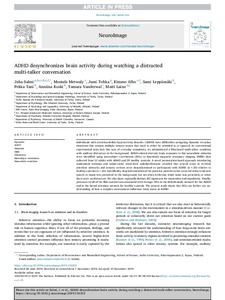ADHD desynchronizes brain activity during watching a distracted multi-talker conversation
Anniina Koski; Juha Salmi; Mostafa Metwaly; Matti Laine; Jussi Tohka; Kimmo Alho; Sami Leppämäki; Tamara Vanderwal; Pekka Tani
https://urn.fi/URN:NBN:fi-fe2021042827261
Tiivistelmä
Individuals with attention-deficit/hyperactivity disorder (ADHD) have difficulties navigating dynamic everyday situations that contain multiple sensory inputs that need to either be attended to or ignored. As conventional experimental tasks lack this type of everyday complexity, we administered a film-based multi-talker condition with auditory distractors in the background. ADHD-related aberrant brain responses to this naturalistic stimulus were identified using intersubject correlations (ISCs) in functional magnetic resonance imaging (fMRI) data collected from 51 adults with ADHD and 29 healthy controls. A novel permutation-based approach introducing studentized statistics and subject-wise voxel-level null-distributions revealed that several areas in cerebral attention networks and sensory cortices were desynchronized in participants with ADHD (n = 20) relative to healthy controls (n = 20). Specifically, desynchronization of the posterior parietal cortex occurred when irrelevant speech or music was presented in the background, but not when irrelevant white noise was presented, or when there were no distractors. We also show regionally distinct ISC signatures for inattention and impulsivity. Finally, post-scan recall of the film contents was associated with stronger ISCs in the default-mode network for the ADHD and in the dorsal attention network for healthy controls. The present study shows that ISCs can further our understanding of how a complex environment influences brain states in ADHD.
Kokoelmat
- Rinnakkaistallenteet [19207]
